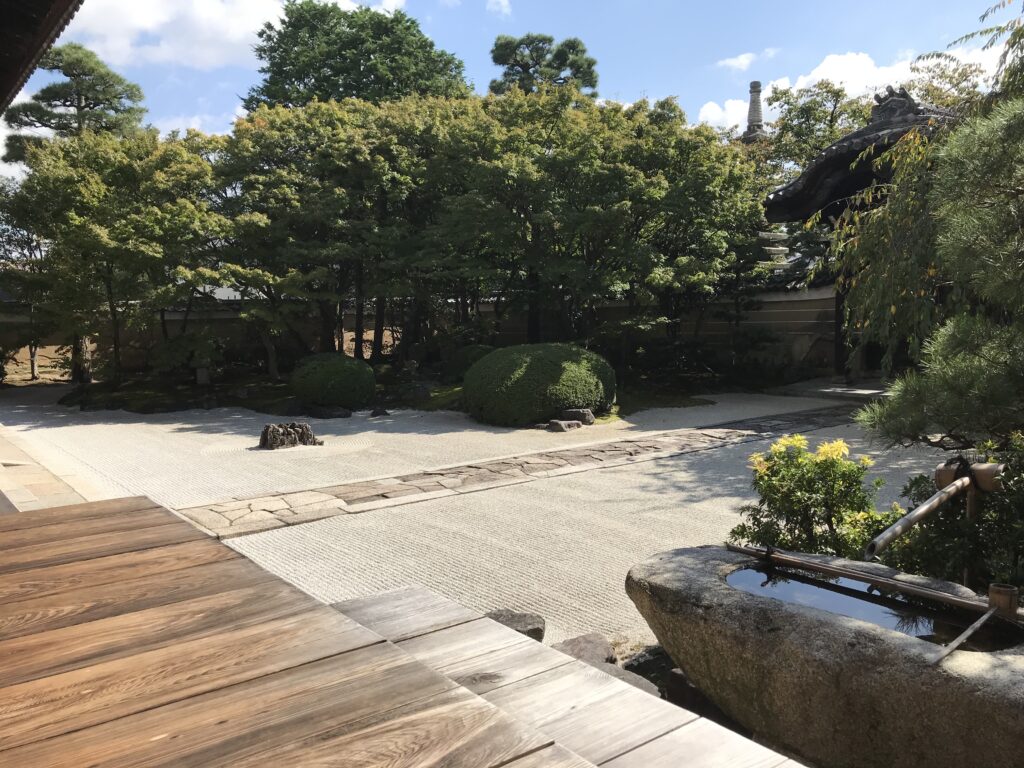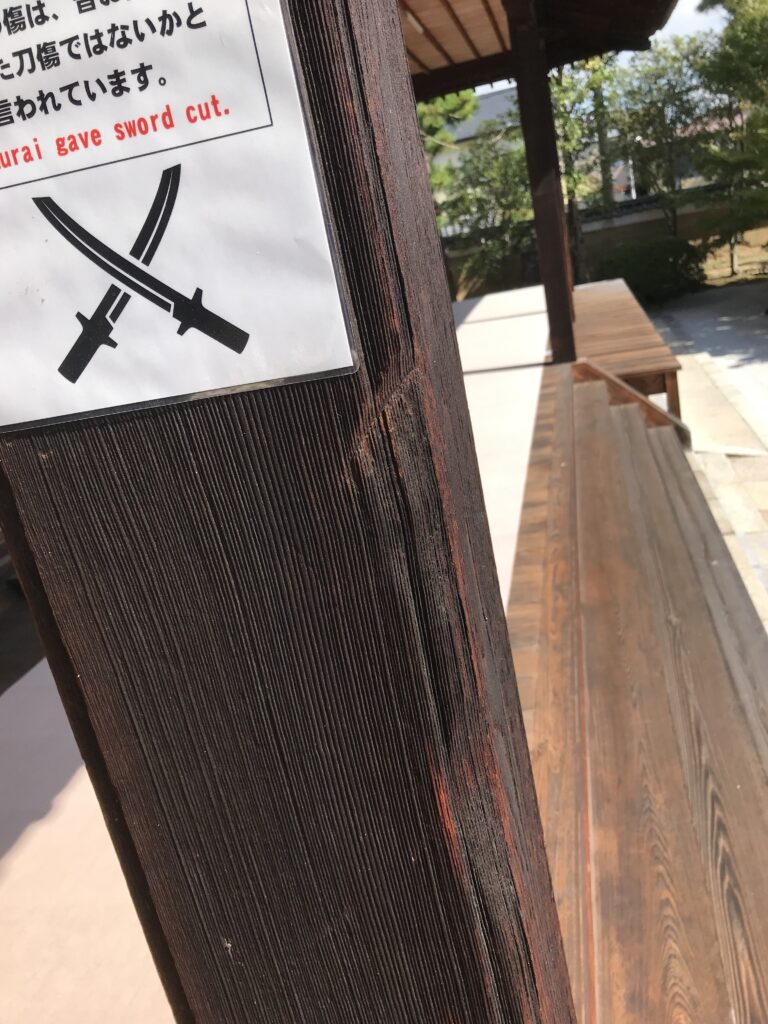ふと入ったお寺
神仏霊場会の公式ガイドブックを片手に京都界隈を歩いていると、知らないお寺によく出くわします。お寺に対して大分鼻が利くようになったのか、この妙顕寺の前を通りかかったとき、ここは何かありそうだと感じて、中に入ってみました。

4つの庭園を持つお寺
後で調べると、このお寺は鎌倉時代末期(1321年)に創建された、京都における日蓮宗最初の寺院だそうです。境内を奥に進むと、庭園が拝観可能と書かれており、見させていただくことにしました。最初に「四海唱導の庭」と呼ばれる、勅使門の前に広がる庭です。季節によれば、桜や紅葉が楽しめるそうです。


妙顕寺は豊臣秀吉が住んでいたお寺との掲示がありました。そのため、客殿の柱の刀傷は、その昔、お侍さんがつけたものではないかと言われているそうです。よく見ると、刀が刺さった傷と、木を削ったような傷があります。

樹齢何百年の大きな松
建物の中を歩いていくと、大きな松が2本植えられた「光琳曲水の庭」に出ました。右側の黒松は樹齢200年、左側の赤松は樹齢400年の大木です。円窓から見える庭の景色も、額縁効果が効いていて、いいですね。そういえば、大木が主役の庭というのは、あまりお目にかかったことがありませんでした。スケール感があって、気に入りました。



最後は水琴窟
最後は「五色椿と松の庭」です。その名の通り、五色の椿が植えられています。冬ではなかったので、花自体を見ることはできませんでしたが、庭の中央に水琴窟が備えられています。水琴窟内で水がはじける音が好きなので、庭におりて手水鉢の水をかけて、かすかな音を楽しんできました。このお寺には、もう一つ、竹の坪庭と呼ばれる小さな中庭もあります。ふらっと入ったお寺でしたが、十分楽しむことができました。(完)


妙顕寺の御朱印

京都を学ぶ書籍
宗派別にたくさんのお寺も紹介されています。

新版 京都・観光文化 検定試験 公式テキストブック 公式テキストブック [ 京都商工会議所 ]
価格:2,420円
(2021/9/11 14:06時点)
感想(5件)
Myorenji Temple (English)
A temple I stumbled into
Walking around Kyoto with the official guidebook of the Association of Shinto Shrines and Buddhist Temples in my hand, I often come across unfamiliar temples. When I passed by this temple, I felt that there was something there, so I went inside.
A temple with four gardens
Later, I found out that this temple was founded in 1321, the end of the Kamakura period (1185-1333), and was the first Nichiren Sect temple in Kyoto. As I walked deeper into the temple grounds, I saw that the garden was open to the public, so I decided to take a look. The first garden is called “Shikai Shodou no Niwa,” which is the garden in front of the imperial gate. According to the season, you can enjoy cherry blossoms and autumn leaves.
There was a notice saying that Myokenji Temple was the temple where Toyotomi Hideyoshi lived. Therefore, it is said that the sword scars on the pillars of the guest hall may have been made by a samurai in the past. If you look closely, you can see a scar where a sword was stuck and a scar that looks like it was scraped off the wood.
Large pine trees hundreds of years old
Walking through the building, I came to the “Korin Kyokusui Garden” with two large pine trees. The black pine tree on the right is 200 years old and the red pine tree on the left is 400 years old. The view of the garden through the circular window also has a nice framing effect. Come to think of it, I have not seen many gardens where large trees are the main attraction. It has a sense of scale, and I like it.
Finally, the Suikinkutsu
The last one was the “Garden of Five-Colored Camellias and Pine Trees. As the name suggests, there were camellias of five different colors. Since it was not winter, we could not see the flowers themselves, but there was a Suikinkutsu (a water fountain) in the center of the garden. I like the sound of water splashing in the Suikinkutsu, so I went down to the garden and splashed water from the water bowl and enjoyed the faint sound. The temple also has another small courtyard called the bamboo pond. Although I entered the temple on a whim, I was able to fully enjoy it. (End)
Temple Myorenji (Français)
Un temple dans lequel je suis tombé par hasard
En me promenant dans Kyoto avec le guide officiel de l’Association des sanctuaires shintoïstes et des temples bouddhistes à la main, je tombe souvent sur des temples inconnus. Quand je suis passé devant ce temple, j’ai senti qu’il y avait quelque chose, alors je suis entré.
Un temple avec quatre jardins
Plus tard, j’ai découvert que ce temple avait été fondé en 1321, à la fin de la période Kamakura (1185-1333), et qu’il était le premier temple de la secte Nichiren à Kyoto. En m’enfonçant plus profondément dans l’enceinte du temple, j’ai vu que le jardin était ouvert au public, alors j’ai décidé d’y jeter un coup d’œil. Le premier jardin s’appelle “Shikai Shodou no Niwa”, c’est-à-dire le jardin situé devant la porte impériale. Selon la saison, vous pouvez admirer les cerisiers en fleurs et les feuilles d’automne.
Il y avait un avis disant que le temple Myokenji était le temple où Toyotomi Hideyoshi a vécu. Par conséquent, on dit que les cicatrices d’épée sur les piliers de la salle des invités peuvent avoir été faites par un samouraï dans le passé. Si vous regardez attentivement, vous pouvez voir une cicatrice où un sabre a été planté et une cicatrice qui semble avoir été grattée sur le bois.
De grands pins vieux de plusieurs centaines d’années
En traversant le bâtiment, je suis arrivé au “Korin Kyokusui Garden” avec deux grands pins. Le pin noir à droite a 200 ans et le pin rouge à gauche a 400 ans. La vue du jardin à travers la fenêtre circulaire a également un bel effet de cadrage. En y réfléchissant, je n’ai pas vu beaucoup de jardins où les grands arbres sont l’attraction principale. Il y a un sens de l’échelle, et j’aime ça.
Enfin, le Suikinkutsu
Le dernier était le “Jardin des camélias et des pins de cinq couleurs”. Comme son nom l’indique, il y avait des camélias de cinq couleurs différentes. Comme ce n’était pas l’hiver, nous ne pouvions pas voir les fleurs elles-mêmes, mais il y avait un Suikinkutsu (une fontaine d’eau) au centre du jardin. J’aime le bruit de l’eau qui éclabousse le Suikinkutsu, alors je suis descendu dans le jardin et j’ai fait couler de l’eau du bol d’eau et j’ai apprécié ce léger bruit. Le temple possède également une autre petite cour appelée l’étang de bambou. Bien que je sois entré dans le temple sur un coup de tête, j’ai pu en profiter pleinement. (Fin)
